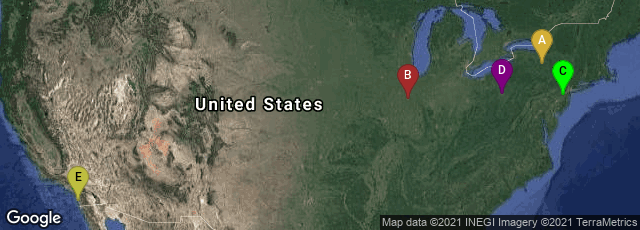
A: Ithaca, New York, United States, B: Urbana, Illinois, United States, C: Princeton, New Jersey, United States, D: Pittsburgh, Pennsylvania, United States, E: San Diego, California, United States
In 1986 the National Science Foundation Network connected five new supercomputer centers and allowed access to these centers at no cost. The centers, which the NSF funded in 1985, were: the John von Neumann Center at Princeton, the San Diego Supercomputer Center at UCSD, the National Center for Supercomputing Applications at UIUC, the Cornell Theory Center at Cornell, and the Pittsburgh Supercomputing Center.
NSFNET used a TCP/IP-based protocol compatible with ARPANET, as a backbone to which regional and academic networks would connect. It experienced exponential growth in its network traffic. As a result of a November 1987 NSF award to a consortium of universities in Michigan, the original 56- kbit/s links was upgraded to 1.5 Mbit/s by July 1988 and again to 45 Mbit/s in 1991.
"The NSFNET was the principal Internet backbone starting in approximately 1988, bridging between the rather restrictive US DoD creation of the Internet, and its broad commercialization in the mid-1990s. Basically, the NSFNET opened up the Internet to the world. Some critical Internet technologies, such as the Border Gateway Protocol (BGP) are a direct result of that period in Internet history. BGP was specifically created to allow the NSFNET backbone to differentiate routes learned via multiple paths from originally the Arpanet, but also from the regional networks. This then turned the Internet into a meshed infrastructure, backing away from the single-core architecture which the Arpanet had been using before."